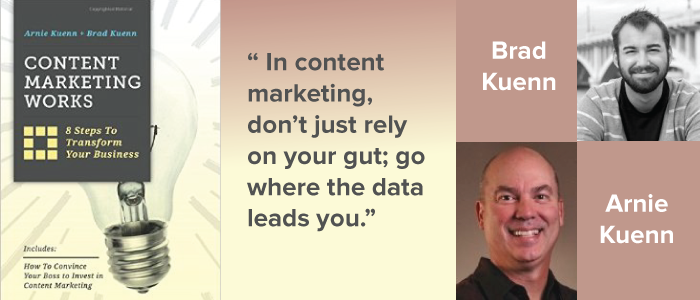- Share Content Marketing Works: Plan with a Purpose [Book Review & Interview] on Facebook
- Share Content Marketing Works: Plan with a Purpose [Book Review & Interview] on Twitter
- Share Content Marketing Works: Plan with a Purpose [Book Review & Interview] on Linkedin
- Share Content Marketing Works: Plan with a Purpose [Book Review & Interview] via email
As content marketers, we are constantly looking for best practices to stay on top of our game.
Most people will turn to search engines, typing in keywords and questions such as “blog topic ideas” or “best way to distribute content” only to be met with a never-ending list of articles, eBooks and thought leadership pieces. Many of these results are high quality, but they often come from unknown sources and sometimes offer conflicting solutions.
How can we make sense of it all?
One answer is to pick up a copy of Content Marketing Works, a 290-page handbook written by Vertical Measures CEO Arnie Kuenn and Content Strategist Brad Kuenn. I recently read this book and found that it answered many of the questions I ask as a content marketer.
The Kuenns were able to cover eight different steps of a content marketing process, create a set of best practices and provide endless examples of quality pieces of content. Instead of explaining content marketing in a conceptual sense, this book is all about value, complete with a glossary of marketing terms. There is even an entire section dedicated to convincing your boss of the worth of content marketing.
To give you a small taste, take a look at four of my favorite quotes from the book. Then, keep reading for an exclusive interview with author Arnie Kuenn.
Visit the book’s official page to download it for free.
1. “Provide quality content that solves the toughest problems your market faces.”
When creating a content strategy and deciding which overall themes to cover, you should first think about common issues prospects are facing. This way, people can rely on you for your expertise and eventually become your customers.
One way to do this? The Kuenns recommend creating personas and identifying what each of these target audiences struggle with on a day-to-day basis.
2. “ In content marketing, don’t just rely on your gut; go where the data leads you.”
When it comes to content ideation in particular, the Kuenns suggest finding out what audiences are already interested in by looking at data and analytics. To do this, use a variety of tools, such as:
- Google Analytics and Adwords Keyword Planner. This tool lets you compare search volume data for various keywords and also find related keywords. This can help you choose new topics to tackle.
- Google Suggest. Use this to see what people are actually looking for (i.e. not just grand canyon, but also what the best time is to visit it)
- Industry-related LinkedIn Groups. Join as many LinkedIn groups in your industry as possible and monitor all discussions. Create content that addresses common questions in these groups.
3. “People love stories. When we share our lives with one another, we do it through stories. We meet over coffee to talk about what happened to us at work; we call our friend up to tell a story about our crazy party last night.”
According to the Kuenns, telling stories is a no-brainer. In real-life conversation, people are attracted to great stories and it’s the same when it comes to content. To create a story that will fascinate audiences, the Kuenns provide several tips, including:
- Learn from the masters. Storytelling is an ancient art and stretches far beyond content marketing. Become inspired by fiction and non-fiction writers, playwrights, directors and actors. What do you like about these people’s stories? Use these insights in your own writing.
- Show your personality. Without a unique voice, content becomes run-of-the-mill. Infuse your own personality into each piece of content and readers will gravitate towards it.
- Be honest. A beautifully woven story is worthless if it isn’t true. Readers will find out and your credibility will be diminished.
4. “Want to know the secret to optimizing content for search and social media? Solve people’s problems.”
While there is a lengthy list of best practices for SEO and social media (all outlined in this book), the authors also don’t want you to lose sight of problem solving. If you spend all your time on optimization, your content may be found. But, if it serves no purpose to the reader, they won’t stay on the page.
These are just a few of the nuggets of knowledge found in this book. For more in-depth, specific instructions, be sure to download the book and keep it on file – I have a feeling you’ll be referencing it for some time to come.
I also recently had the chance to chat with author Arnie Kuenn about Content Marketing Works and future of content marketing. See this interview below:
What inspired you to write this book?
“It was really a combination of three things. First, people in our office started asking when I was going to write a follow up to Accelerate!. I kept telling them I hadn’t gotten over the pain of writing that first book – but deep down I knew it was time. Second, so much had happened in our industry since Accelerate! came out in 2011. There was Google’s Panda, Penguin, Hummingbird and other important updates. There was the surge in interest in content marketing. And as an agency we were seeing all sorts of success stories and felt very confident we knew what it took to make content marketing work. Third, my son is a content strategist and writer. One day he said “come on pops, I’ll help you with this…” and that was all it took to get started.”
What were some challenges you encountered while writing this book?
“I think getting the book written and published while all the information is still relevant was the biggest challenge. If you have ever been through this process you know that once you finish writing, there are still months to go before the book is actually published and available to the readers. During those months you just pray that nothing major happens in the industry that would cause you to go back and make major edits. The other big issue is always the editing. It’s one thing to get all your thoughts down. It’s another thing to make sure it is readable, interesting and has no (or almost no) typos or grammatical errors. And yes, Content Marketing Works still ended up having a couple of typos.”
Where do you see the future of content marketing?
“We actually published an entire ebook on this. I think we are still in the early stages of content marketing, so the future is different for many companies. There are those that are only aware of the concept and still need to start. For them they just need to get started and work on making it part of their culture. Then there are those who have started and still need to get the fundamentals down, with the proper systems in place. Then there are the minority of organizations that are off and running. For those companies I see them implementing more motion based content, interactive content and more video content.”
Out of the 16 examples of content you provide in your book, what is your favorite one and why?
“Without any doubt it is free guides, white papers, case studies and ebooks. We call that the core or hub content. For many of our clients we implement a hub and spoke strategy where those “guides” are the hubs and the spokes would be articles/blog posts, tweets, LinkedIn updates, Facebook posts, Pinterest images, press releases and guest posts on 3rd party sites. All of those spokes would point back to promote the hub. The ‘guides’ are evergreen, and are great for generating leads and often attract really solid links.”
What is one piece of advice you would like to give to every content marketer?
“Keep going! It’s one thing to say you are a content marketer, attend the conferences, read the blog posts, totally understand the concept and even create that strategy. It’s another to actually execute your strategy. Too many times I see companies start only to drastically reduce their effort in the ensuing months. The successful organizations are committed to content marketing and make it part of their permanent culture. They understand the rewards may be a year or more away, but they have a long-term view and eventually will be the ones that pull away from the pack.”
What is the most important lesson you have learned while working in content marketing/writing this book?
“Biggest lesson is to create and faithfully use a content editorial calendar. In our content workshops, and at many of my speaking engagements I tell the audience that if you can get to the point where you have created and follow a detailed content calendar for three months in a row, you are off and running and your odds of success increase dramatically.”
For more tips on forming a content strategy, download our latest eBook 2015 Content Marketing Tactics & Technology Planner, which is chock-full of data and insights from 600+ marketers.










